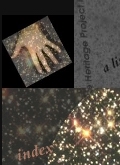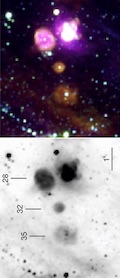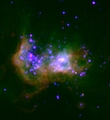



The number and metallicities of the most metal-poor stars
M.S. Oey
A Simple Inhomogeneous Model (SIM) for chemical evolution of the
Galactic halo is applied to two low-metallicity problems: (1) The
predicted number fraction FIII of zero-metallicity,
Population III
stars; and (2) The existence and value of a low-metallicity
threshold. This semi-analytic model modifies the homogeneous Simple
Model by including a metallicity distribution function for the parent,
individual enrichment events, f(z0). Thus, this
SIM model is suited for analysis of the
lowest-metallicity regimes that are dominated by stochastic events.
The current empirical upper limit on the Population III fraction is
FIII < 4e-4. We find that the SIM predicts values of
FIII that are two orders of magnitude above this observed
limit. Thus, accounting for simple inhomogeneity greatly worsens the
discrepancy between observations and predictions than found from the
Simple Model.
MNRAS, 339, 849
|

